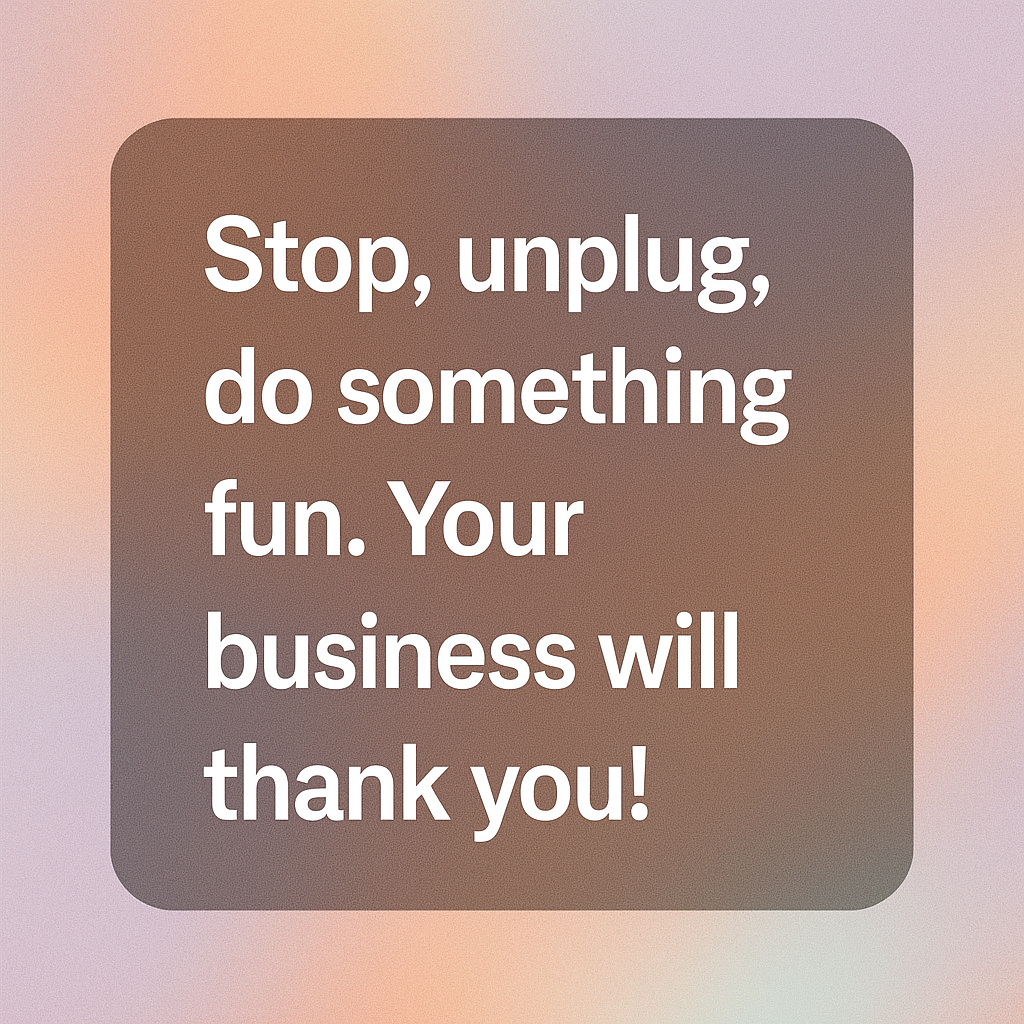
Knowing some work life balance tips is fundamental as nearly 60 percent of solopreneurs report feeling overwhelmed by the constant demands of running their own business. Balancing work and personal life is more than just a scheduling challenge—it directly affects your productivity, mental health, and long-term success. Discover practical ways to find that healthy balance, reclaim your time, and create a business that supports both your professional goals and personal wellbeing.
Table of Contents
- 1. Set Clear Boundaries Between Work and Personal Time
- 2. Use Time Blocking for Focused Productivity
- 3. Automate Routine Tasks to Save Time
- 4. Prioritize Self-Care and Mental Health
- 5. Streamline Client Communication Effectively
- 6. Leverage Technology for Business Efficiency
- 7. Schedule Regular Breaks to Prevent Burnout
Quick Summary
| Takeaway | Explanation |
|---|---|
| 1. Set clear work and personal boundaries | Establish specific work hours to protect mental energy and avoid burnout. Communicate these boundaries to clients for professional sustainability. |
| 2. Implement time blocking for productivity | Allocate time slots for specific tasks to minimize distractions. Identify peak performance hours and group similar tasks together for efficiency. |
| 3. Automate routine tasks for efficiency | Use technology to streamline administrative work like invoicing and appointment scheduling. Focus on core business activities by reducing manual efforts. |
| 4. Prioritize self-care for mental health | Schedule regular breaks and practice mindfulness to maintain emotional balance. Engage in supportive professional networks to boost resilience. |
| 5. Enhance client communication strategies | Establish clear communication expectations and response times. Use templated messages to maintain consistency and enhance client relationships. |
1. Set Clear Boundaries Between Work and Personal Time
As a solopreneur, your work and personal life can easily blur into one overwhelming experience. Setting clear boundaries and knowing some work life balance tips is not just recommended. It is essential for your mental health and professional sustainability.
According to research from the guide on setting boundaries with clients, understanding your personal limits protects both your professional reputation and personal well-being. When you establish precise demarcations between work and personal time, you prevent burnout and create space for genuine productivity.
Why Boundaries Matter:
- Protect your mental energy
- Prevent professional exhaustion
- Create predictable work structures
- Maintain healthy personal relationships
Implementing boundaries requires intentional strategies. Start by defining specific work hours and communicate these clearly to clients. Use digital tools to set automatic email responses outside your designated work time. Create a dedicated workspace that you physically exit when work concludes. This physical transition signals to your brain that professional responsibilities are complete.
As the research from Sutter Health indicates, recognizing that you are not responsible for managing others’ expectations or problems is crucial. Your time is valuable. Your personal space matters. By setting firm boundaries, you demonstrate professional maturity and self respect. Remember: boundaries are not about being rigid. They are about creating sustainable work patterns that allow you to thrive both professionally and personally.
2. Use Time Blocking for Focused Productivity
Time blocking transforms how solopreneurs manage their workday by turning scattered tasks into a strategic productivity system. This method allows you to allocate specific time slots for different responsibilities, ensuring focused work and minimizing distractions.
According to research from the National Association of Self Employed, implementing graded time blocks helps entrepreneurs optimize their productivity by matching tasks with their natural energy levels. When you understand your peak performance periods, you can schedule complex work during high energy times and administrative tasks during lower energy windows.
Key Time Blocking Strategies:
- Identify your most productive hours
- Group similar tasks together
- Create buffer zones between work blocks
- Plan realistic time allocations
Designing an effective time blocking strategy requires understanding your personal work rhythm. Start by mapping out your typical day and identifying when you feel most alert and creative. Some solopreneurs find morning hours ideal for deep work, while others peak in afternoon sessions. Explore productivity apps that can support your time management to help track and optimize your time blocking approach.
Practical implementation means breaking your day into intentional segments. Allocate 90 minute blocks for complex projects that require concentrated effort. Schedule shorter 30 minute intervals for email management, administrative tasks, and routine communications. Include short breaks between blocks to prevent mental fatigue and maintain sustained productivity.
Remember that time blocking is flexible. Your first attempt will not be perfect. Continuously refine your approach based on what actually works for your unique workflow. The goal is creating a personalized system that maximizes your professional output while preserving your mental energy.
3. Automate Routine Tasks to Save Time
In the world of solopreneurship, time is your most valuable asset. Automation is the secret weapon that transforms manual administrative work into streamlined efficiency, allowing you to focus on growing your business and serving clients.
Understanding business automation for freelancers reveals how strategic technological tools can dramatically reduce repetitive tasks. According to research from the National Association of Self Employed, incorporating automation in daily routines significantly reduces manual effort and enhances overall business productivity.
Automation Priority Areas:
- Client onboarding processes
- Invoice and payment tracking
- Social media scheduling
- Email marketing campaigns
- Appointment booking systems
Start by identifying tasks that consume substantial time without requiring your unique expertise. Repetitive administrative work like sending follow up emails, scheduling appointments, or generating invoices are perfect candidates for automation. Many digital platforms now offer integrated solutions that can seamlessly handle these responsibilities.
Implementing automation does not mean replacing human connection. Instead, it means creating more space for meaningful interactions. By reducing time spent on mundane tasks, you can invest more energy into strategic planning, client relationships, and personal professional development.
Consider using tools that integrate multiple functions. Look for platforms that can connect your communication channels, financial tracking, and client management systems. This approach not only saves time but also reduces the potential for human error and creates a more cohesive workflow for your business.
4. Prioritize Self-Care and Mental Health
Solopreneurship is a marathon of personal resilience and professional commitment. Prioritizing your mental health is not a luxury. It is an absolute necessity for sustainable success and personal wellbeing.
According to research from Sutter Health, recognizing your right to personal time and space is crucial for maintaining psychological balance. Mental health is the foundation of your professional performance. When you are mentally strong and emotionally balanced, you make better decisions, communicate more effectively, and sustain higher levels of productivity.
Essential Self Care Strategies:
- Schedule regular mental health breaks
- Practice mindfulness and meditation
- Maintain physical exercise routine
- Connect with supportive professional networks
- Set strict work hour boundaries
Implementing self care requires intentional planning. Start by treating your mental wellness with the same professional rigor you apply to client projects. Block specific time for activities that recharge you. This might mean morning yoga, midday meditation, or weekly therapy sessions. Physical movement particularly helps release stress and improves cognitive function.
Professional isolation can be a significant challenge for solopreneurs. Seek out community connections through professional networks, online forums, or local entrepreneurial groups. These connections provide emotional support, reduce feelings of loneliness, and create opportunities for mutual growth.
Remember that self care is not selfish. By investing in your mental health, you are ensuring your long term professional sustainability. Your ability to serve clients effectively directly correlates with your personal well being. Treat yourself with the same compassion and strategic attention you offer your most valued clients.
5. Streamline Client Communication Effectively
Effective communication is the lifeblood of successful solopreneur relationships. Your ability to communicate clearly and efficiently determines not just client satisfaction but your professional reputation and potential for repeat business.
Understanding client communication tips reveals that structured communication practices significantly reduce misunderstandings and professional friction. According to research from the National Association of Self Employed, establishing clear communication channels and schedules helps manage client expectations and minimize potential conflicts.
Key Communication Strategies:
- Set explicit communication expectations upfront
- Define preferred communication channels
- Establish response time standards
- Create templated communication frameworks
- Schedule regular project check ins
Start by developing a comprehensive onboarding document that outlines your communication approach. This should include your typical response times, preferred contact methods, and communication boundaries. For instance, specify that you answer emails within 24 business hours or provide alternative contact methods for urgent matters.
Utilize technology to your advantage. Many project management and communication platforms offer automated status updates, reducing the need for constant manual check ins. Create email templates for common communications to save time and maintain a consistent professional tone. Remember that consistent does not mean impersonal. Inject your unique personality while maintaining clear and professional communication.
The goal is creating a communication system that respects both your time and your clients professional needs. By setting clear expectations and using strategic communication tools, you transform potential communication challenges into opportunities for building strong, trust based client relationships.
6. Leverage Technology for Business Efficiency
Technology is the silent powerhouse that can transform your solopreneur operation from overwhelmed to optimized. Strategic technological integration allows you to work smarter, not harder, creating space for both professional growth and personal well being.
Understanding the benefits of business automation reveals how digital tools can dramatically streamline your workflow. According to research from the National Association of Self Employed, adopting technological tools can automate administrative tasks and allow solopreneurs to focus on their core business activities.
Technology Integration Strategies:
- Select multi functional software platforms
- Automate repetitive administrative tasks
- Use cloud based collaboration tools
- Implement smart project management systems
- Integrate financial tracking applications
Start by conducting a comprehensive audit of your current workflows. Identify tasks that consume significant time without requiring your unique expertise. These are prime candidates for technological intervention. Look for integrated platforms that can handle multiple functions like client management, invoicing, scheduling, and communication.
Choosing the right technology is about finding tools that complement your working style. Not every shiny new app will improve your efficiency. Prioritize user friendly platforms with robust integration capabilities. Consider tools that can communicate with each other, creating a seamless ecosystem that reduces manual data entry and minimizes potential errors.
Remember that technology should serve you. The goal is creating a digital infrastructure that supports your business objectives while preserving your personal energy. By strategically leveraging technological solutions, you transform potential administrative burdens into streamlined, efficient processes.
7. Schedule Regular Breaks to Prevent Burnout
Burnout is the silent productivity killer that can derail even the most passionate solopreneur. Strategically scheduled breaks are not a luxury. They are a critical business survival mechanism that protects your most valuable asset your mental and physical energy.
How to handle burnout as a solopreneur reveals the importance of proactive break management. According to research from the Executive Function Toolkit, implementing techniques like the Pomodoro Method can sustain attention and dramatically reduce professional fatigue.
Break Strategy Components:
- Use structured break intervals
- Create diverse break activities
- Practice mindful disconnection
- Set clear break boundaries
- Track break effectiveness
The Pomodoro Technique offers a scientifically backed approach. Work intensely for 25 minutes, then take a 5 minute break. After four consecutive work cycles, reward yourself with a longer 15 to 30 minute break. This method transforms break time from a potential productivity interruption into a strategic performance enhancement tool.
Breaks are not about doing nothing. They are about intentional mental reset and physical restoration. Use your breaks to stretch, hydrate, walk outside, practice brief meditation, or engage in a non work related activity that refreshes your cognitive capabilities. The key is creating a break routine that genuinely recharges your energy instead of simply killing time.
Remember that break scheduling is a skill. Experiment with different approaches to find what works best for your unique work rhythm. Your breaks should feel restorative not restrictive. By treating break time as a professional performance strategy, you transform potential burnout into sustained entrepreneurial excellence.
Below is a comprehensive table summarizing strategies for solopreneurs to enhance productivity, communication, and well-being as discussed in the article.
| Strategy | Implementation | Expected Results |
|---|---|---|
| Set Clear Boundaries | Define work hours, communicate to clients, create dedicated workspace | Protect mental energy, prevent burnout, maintain personal relationships |
| Time Blocking | Identify productive hours, group tasks, use buffer zones | Optimize productivity, match tasks with energy levels |
| Automate Routine Tasks | Use technology for client onboarding, invoicing, and scheduling | Reduce manual efforts, enhance efficiency |
| Prioritize Self-Care | Schedule mental health breaks, practice mindfulness, connect with networks | Sustain professional success, improve decision-making |
| Streamline Communication | Set communication expectations, use templates, schedule check-ins | Reduce misunderstandings, build trust |
| Leverage Technology | Integrate multi-functional tools, automate administrative tasks | Work smarter, reduce errors, create seamless workflows |
| Schedule Regular Breaks | Use methods like Pomodoro, engage in varied activities | Prevent burnout, sustain attention and performance |
Achieve Work-Life Balance with Smarter Business Management
Balancing your professional and personal life as a solopreneur is challenging when every task demands your attention. This article highlights the importance of setting clear boundaries, automating routine tasks, and managing client communication to protect your mental energy and boost productivity. You deserve tools that simplify these challenges while helping you maintain autonomy and focus on what matters most.

Take control of your workday with Fluum’s all-in-one platform designed specifically for solopreneurs. Automate administrative tasks, streamline client management, and set clear boundaries between work and personal time without technical headaches. Explore how business automation works for freelancers and discover personalized productivity strategies through our curated resources. Ready to create sustainable work patterns and reclaim your time Build your balanced business today by visiting Fluum pricing plans and start transforming your solopreneur journey now.
Frequently Asked Questions
How can I set clear boundaries between work and personal time as a solopreneur?
Setting clear boundaries involves defining specific work hours and communicating them to clients. Create a dedicated workspace you physically exit when work is done to signal the end of your professional responsibilities.
What are effective time blocking strategies for managing my day?
Effective time blocking strategies include identifying your most productive hours, grouping similar tasks together, and creating buffer zones between work blocks. Start with 90-minute blocks for focused tasks and shorter intervals for routine tasks to enhance your productivity.
How can I effectively automate routine tasks to save time?
Identify repetitive tasks that drain your time and look for automation solutions tailored for those tasks, such as invoicing or appointment scheduling. This can help you reclaim hours each week, allowing you to focus more on client relationships and strategic planning.
What self-care practices should I prioritize as a solopreneur to maintain my mental health?
Prioritize regular mental health breaks, mindfulness practices, and physical exercise routines. Schedule specific time for these activities, treating them as important as client projects to support your overall well-being.
How can I streamline client communication to enhance my professional relationships?
Streamline client communication by setting clear expectations on response times and preferred channels. Create templated responses for common inquiries to save time while ensuring your communication remains personalized and professional.
What technology can I use to enhance my business efficiency as a solopreneur?
Select multifunctional software platforms that can automate tasks like client management and invoicing. Conduct an audit of tasks you can delegate to technology, aiming to reduce your manual effort and free up time for core business activities.
Recommended
- How To Handle Burnout As A Solopreneur Effectively
- 7 Essential Business Goals Objectives For Solopreneurs
- How To Handle Difficult Clients Effectively For Solopreneurs
- Digital Marketing Fundamentals For Solopreneur Success
- Fluum | Effective Stress Management Techniques for Busy Professionals
- Fluum | How to Onboard Clients Effectively for Lasting Success
- Fluum | Master Managing Multiple Projects for Success
- Fluum | Build Your Brand with a Branding Builder in 2025
- Fluum | 7 Customer Retention Examples to Boost Your Business



